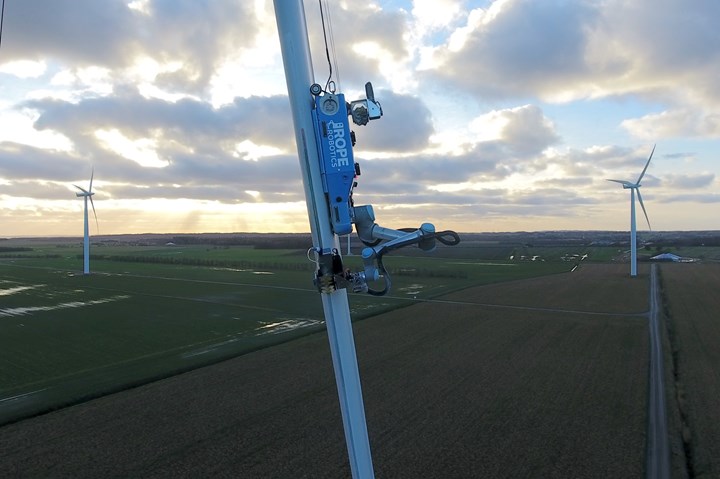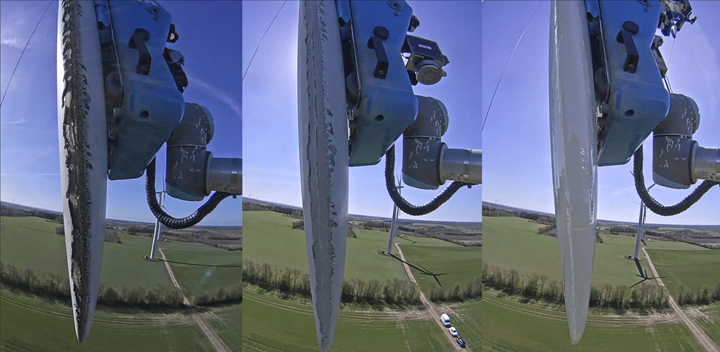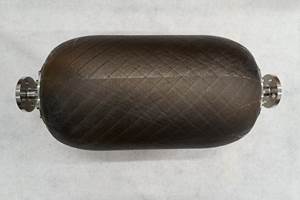Rope Robotics automates onshore wind turbine blade repairs
Patented robot uses visual sensors to diagnose any potential damage for remote operators, and initiates a repair process in real time that is four times faster than manual alternatives.
After more than 18 months in operation, having repaired 150+ rain-damaged onshore wind turbine blades in the U.S., Canada, South Africa and Europe, the patented “BR-8” robot from Rope Robotics (Aarhus, Denmark), has demonstrated return on investment (ROI) for wind turbine owners within just six months. Compared to manual alternatives, the robot can repair the blade around four times faster at half the cost, the company contends.
An increasing problem, rain erosion damage compromises aerodynamic performance of the blade and, at worst, can lead to blade failure and expensive turbine downtime. The repairs offered by Rope Robotics is said to not only restore turbine power output but are quick, cost-effective and efficient as well as safe for technicians to perform in all but the most inclement weather conditions. Previously, technicians have had to abseil from the nacelle to the blade and work with harmful chemicals, a high-risk work environment that is weather-dependent and costly. Moreover, leading-edge repair accounts for some 25-30% of the build cost of the wind turbine.
“Rain erosion is an already serious and worsening issue with the longer rotor blades generating tip speeds of over 380 kilometers per hour,” Martin Huus Bjerge, CEO, Rope Robotics, explains. “Rain drops at that speed act like a hail of bullets that, over time, damage the leading edge of the blade.”
Rope Robotics’ “BR-8” robot can restore up to 3% energy output within less than one day per blade at half the cost of manual solutions, the company says. In addition to its aforementioned commercial operations, Rope Robotics is applying results from onshore repairs in countries like Denmark, Sweden and Germany — the information received will better inform in-progress test repairs on offshore turbines, in preparation for a commercial launch scheduled at the end of 2023.
After leading-edge damage has been established, typically by drones, the wind farm or service provider contracts Rope Robotics, who supplies the robot along with technician training and support on site.
The core of the system is a robot carrying visual sensors, which operates repair tools using a flexible arm, with technicians monitoring the robot from any location, on site or remotely.
On site, the 150-kilogram robot is first attached to ropes that have been anchored in the nacelle before it is hoisted some 100 meters from the ground onto the damaged blade, which has been fixed in a vertical position. A vacuum system enables the robot to attach itself firmly while motors provide movement across the blade. Using its onboard high-resolution camera and laser scanner, the robot inspects the surface, sending images to the remote operator, who diagnoses the damage and initiates the repair process in real time.
The three-phase repair process starts with sanding the damaged area, applying appropriate speed and force to create a pattern ensuring surface roughness and geometry. A second tool cleans the surface using a brush and alcohol to remove dirt and grease. The patented dosing tool applies the leading-edge protective (LEP) material while the spreader tool, also patented, rebuilds the optimal aerodynamic blade shape, smoothing the material to pre-defined standards.
Controlled remotely on-screen by a technician viewing live images, Rope Robotics says the robot performs each step with high precision and consistency, thus ensuring quality. All images are recorded and serve as documentation, a global requirement for wind turbine maintenance.
Awarded two patents covering the robot system, the method, the spreading tool and the dosing tool, the robot took five years to develop and was launched in 2021. The robot has been proven in the field at wind speeds of up to 14 meters per second, relative humidity of up to 80% and temperatures from 0-40ºC. Using results received from other blade repairs, Rope Robotics says it is investing in artificial intelligence (AI) to offer autonomous repairs in the future.
Related Content
Composites end markets: Batteries and fuel cells (2024)
As the number of battery and fuel cell electric vehicles (EVs) grows, so do the opportunities for composites in battery enclosures and components for fuel cells.
Read MoreDrag-based wind turbine design for higher energy capture
Claiming significantly higher power generation capacity than traditional blades, Xenecore aims to scale up its current monocoque, fan-shaped wind blades, made via compression molded carbon fiber/epoxy with I-beam ribs and microsphere structural foam.
Read MoreHonda begins production of 2025 CR-V e:FCEV with Type 4 hydrogen tanks in U.S.
Model includes new technologies produced at Performance Manufacturing Center (PMC) in Marysville, Ohio, which is part of Honda hydrogen business strategy that includes Class 8 trucks.
Read MoreNCC reaches milestone in composite cryogenic hydrogen program
The National Composites Centre is testing composite cryogenic storage tank demonstrators with increasing complexity, to support U.K. transition to the hydrogen economy.
Read MoreRead Next
Plant tour: Daher Shap’in TechCenter and composites production plant, Saint-Aignan-de-Grandlieu, France
Co-located R&D and production advance OOA thermosets, thermoplastics, welding, recycling and digital technologies for faster processing and certification of lighter, more sustainable composites.
Read More“Structured air” TPS safeguards composite structures
Powered by an 85% air/15% pure polyimide aerogel, Blueshift’s novel material system protects structures during transient thermal events from -200°C to beyond 2400°C for rockets, battery boxes and more.
Read MoreDeveloping bonded composite repair for ships, offshore units
Bureau Veritas and industry partners issue guidelines and pave the way for certification via StrengthBond Offshore project.
Read More














.jpg;maxWidth=300;quality=90)










